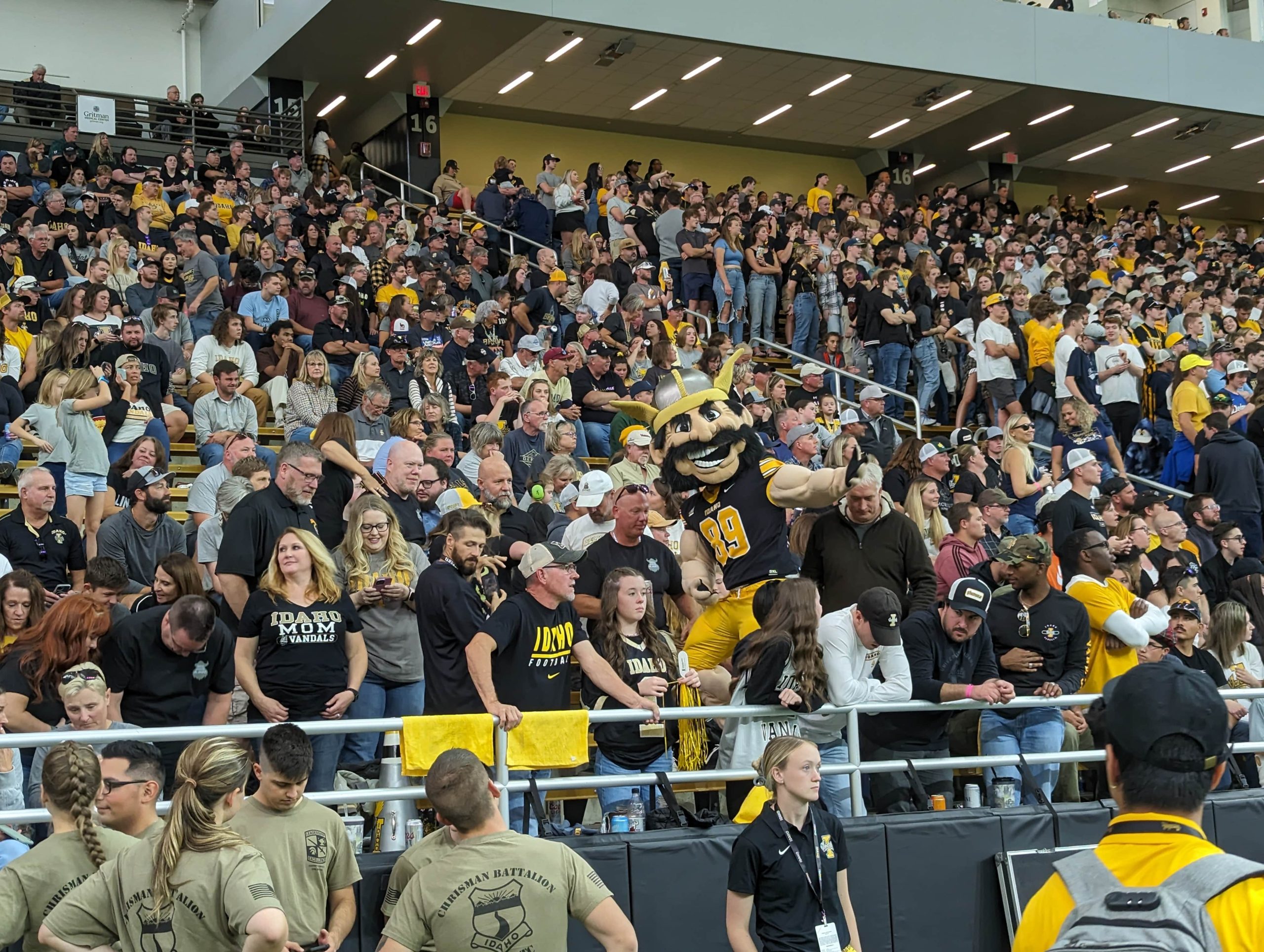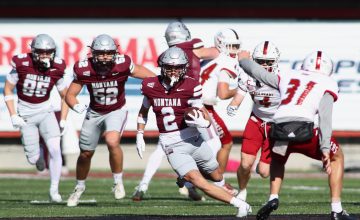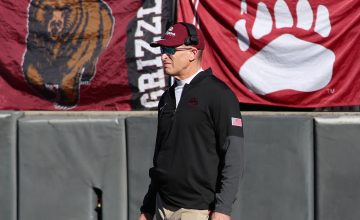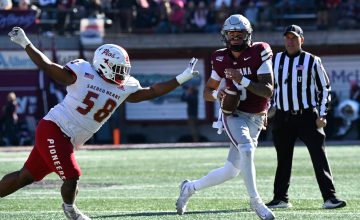Minutes after Ormanie Arnold’s scoop and score on the final play made the final margin of Idaho’s win over Sacramento State 36-27, Vandals kicker Ricardo Chavez sat against the wall in one of the tunnels on the east side of the Kibble Dome. He stared down at his phone, No. 1 jersey already off, yellow and pink Nike soccer cleats still on his feet.
Those feet – the left one for punting, the right one for place-kicking – had just helped Idaho to a program-defining win over the Hornets on Sept. 23, sealed when Chavez’s 30-yard field goal split the uprights with one second left to put the Vandals up 30-27 before Arnold’s cherry-on-top touchdown.
A few feet from Chavez, head coach Jason Eck walked out of the mouth of the tunnel, holding his daughter Lola in one arm and checking the stat sheet with the other. White Air Max on his feet, white visor on his head. Drenched in sweat, he still managed to dap up the marching band as they streamed off the field past him, returning congratulations in a voice hoarse from coaching the Vandals to a win over the No. 4 team in the country. It was only Sac State’s second Big Sky Conference loss since the beginning of 2019 — and arguably Idaho’s signature Big Sky win since returning to the league the year before that.
In 2022, Eck’s jubilantly cocky hoisting of the Little Brown Stein on the field at Montana marked Idaho’s gate-crashing return to the national stage.
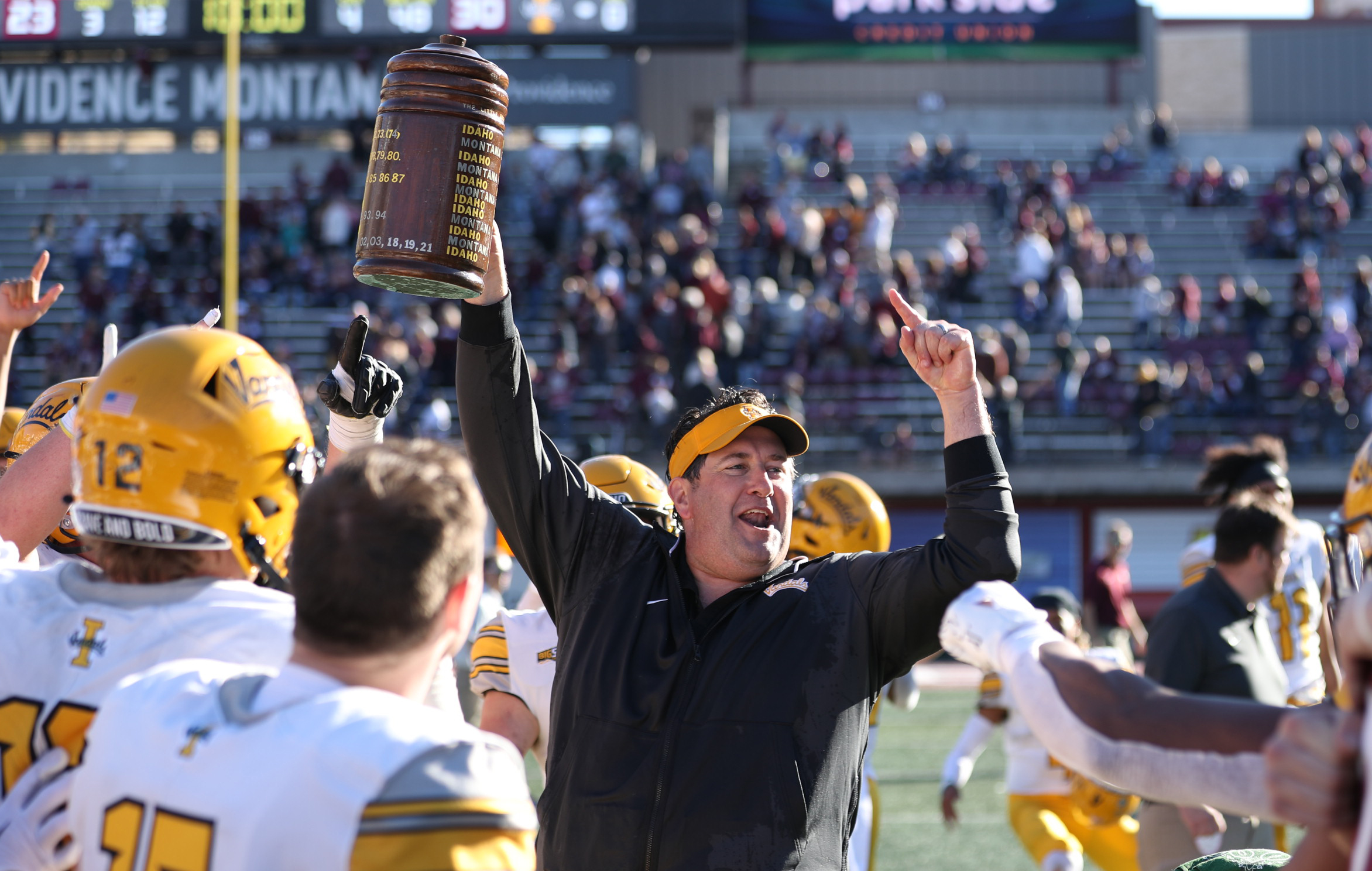
A year later, a little more subdued, he felt less like the brash new kid on the block and more like the appropriately confident avatar of a program on the rise, writing the next chapter in one of the best stories going in small-school college football.
Make no mistake, beating the Hornets – three-time defending Big Sky champions, who were coming off a win over Stanford in which they looked straight-up better than the Cardinal – was an order of magnitude more impressive than beating a Montana team that turned out to be a grade above mediocre last year. It’s just that, as the weeks continue to spin off the calendar, that kind of success looks less and less like a fluke.
After not winning more than five games in a season since returning to the FCS in 2018, Idaho is 12-6 under Eck, and 11-3 against the FCS. After multiple narrow FBS losses last season, they smoked Nevada 33-6 in early September before going up 17-0 on Cal the next week in an eventual 31-17 loss. The Vandals replaced Sac State as the No. 4 team in the country after their big win and are now up to third as they prepare to host No. 16 Montana on Saturday night in a game that will be nationally broadcast on ESPN2.
It’s easy to forget, but that kind of success was once common for Idaho. Starting in 1982, former Montana State quarterback Dennis Erickson coached the Vandals to 32 wins and a pair of playoff berths before leaving for Wyoming following the 1985 season. Idaho won or shared the league title eight times between 1982 and 1992, qualifying for the Division I-AA playoffs 11 times during that span – nearly three times more than Montana (three), Montana State (one) and Eastern Washington (zero) combined.
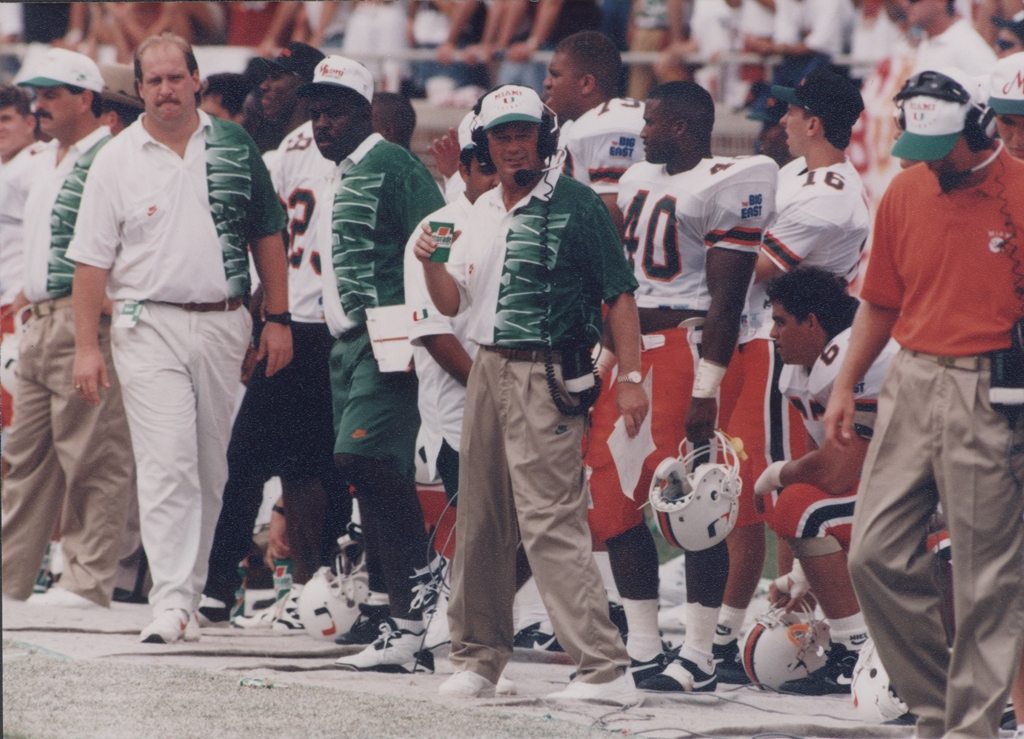
Moscow was a coaching cradle, launching both Erickson (who eventually won two national titles at Miami) and John L. Smith (who wound up at Michigan State and Arkansas) into the FBS spotlight.
Former Montana State head coach Jeff Choate remembered driving from his hometown of Saint Maries, Idaho, on the White Pine scenic highway to “watch the Kamiah Kid (Ken Hobart) sling it around the Kibbie Dome.” Choate was 12 when Erickson took over and installed his vaunted single-back offense, sparking Hobart to throw for a combined 6,676 yards and 56 touchdowns his junior and senior years. Vandal QBs John Freisz and Doug Nussmeier won Walter Payton Awards four years apart in 1989 and 1993; Freisz was the first Big Sky Conference player to win the award and Nussmeier, who’s now Justin Herbert’s quarterbacks coach for the Los Angeles Chargers, was the third.
But two years after Nussmeier’s win – and three years after winning what’s still their last Big Sky title in 1992, their fifth in eight years – the Vandals jumped from Division I-AA to Division I-A, from the Big Sky to the Big West, kicking off a 20-plus-year stretch of wandering the forgotten outskirts of the supposed big time.
There were some good moments. Idaho owns a 3-0 all-time bowl record thanks to wins in the 1998 and 2009 Humanitarian Bowls and 2016 Potato Bowl. The Kibbie Dome, despite being the second-smallest venue in the FBS, gained a cult following, thanks largely to its inclusion in the EA Sports NCAA Football video game series. But none of that obscured the nagging fact that the Vandals, for almost all of their time in the FBS, were a team without a home.
They spent time in the Big West, the Sun Belt, the WAC and as an independent. The Big West dissolved under them after the 2000 season. So did the WAC, in 2012. The Sun Belt took Idaho in both times, but that was never a natural fit, given the name of the conference and the fact that the Sun Belt doesn’t currently have a team west of Texas State or north of James Madison.
In the Big Sky, Idaho had natural, historic rivals in the ‘Cats, the Griz, the Eags and the in-state Idaho State Bengals. But they forfeited all of that to chase the pace set by Boise State, which never worked out because the Broncos got into the Mountain West and the Vandals were stuck trying to forge rivalries with teams in Alabama, Georgia and Arkansas.
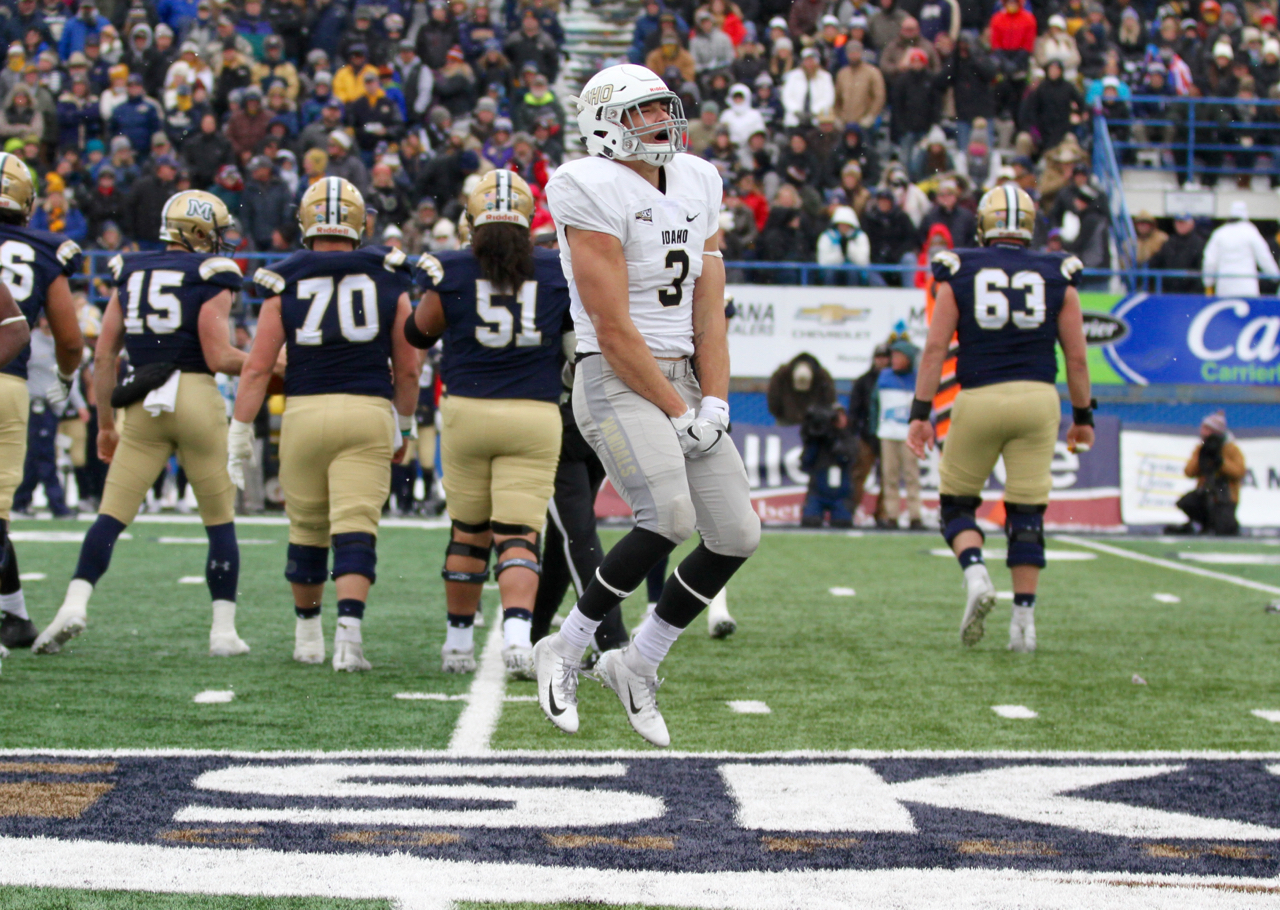
Idaho dropped back down to the FCS in 2018, but couldn’t find its former glory under Paul Petrino, going no better than 3-5 in the Big Sky for four straight years despite a collection of standout players.
But not even two seasons after hiring Eck, it feels like the Vandals are back where they belong, reconnecting with their history and ripping up the Big Sky Conference with a creative, charismatic coach, a pencil-thin assassin at quarterback, a three-headed monster at wide receiver and their long-suffering fan base enjoying the ride.
It’s an irresistible story, one I wanted to get a taste of. So when Idaho hosted back-to-back-to-back defending conference champion Sac State on the same weekend Montana played at hard-to-get-to Northern Arizona, I packed my duffel and headed west, looking for the answers behind the turnaround. This is the story of my three days on the Palouse with the Vandals.
To get from Missoula to Moscow, drive west on I-90 for two-and-a-half hours, then turn left at Coeur d’Alene and drive south for another 90 minutes. In Coeur d’Alene, I devour eggs over easy, bacon, potatoes and one-and-a-half out of two plate-sized pancakes at Michael D’s Eatery. It’s an idyll, watching the rain drip on the hanging pink and purple petunias on the outside deck and listening to the buzz of small-town Friday-morning hustle and the delightfully appropriate Fleetwood Mac on the speakers.
Thunder only happens when it’s raining.
South of Coeur d’Alene, the landscape changes. After leaving the city on the lake, the Montana and North Idaho mountains slowly transition into the rolling hills of the Palouse, the up-and-down timbered canyons with small towns clinging to the side of the highway replaced by some of the most fertile land in America.
Even the late-morning fog feels different. It doesn’t hang and menace like it does in the mountains, pierced through by the sharp green shafts of pine trees on the ridgelines like a battle flag caught by the enemy’s spears, ragged and torn. Soft and low, it caresses the land, filling in the valleys.
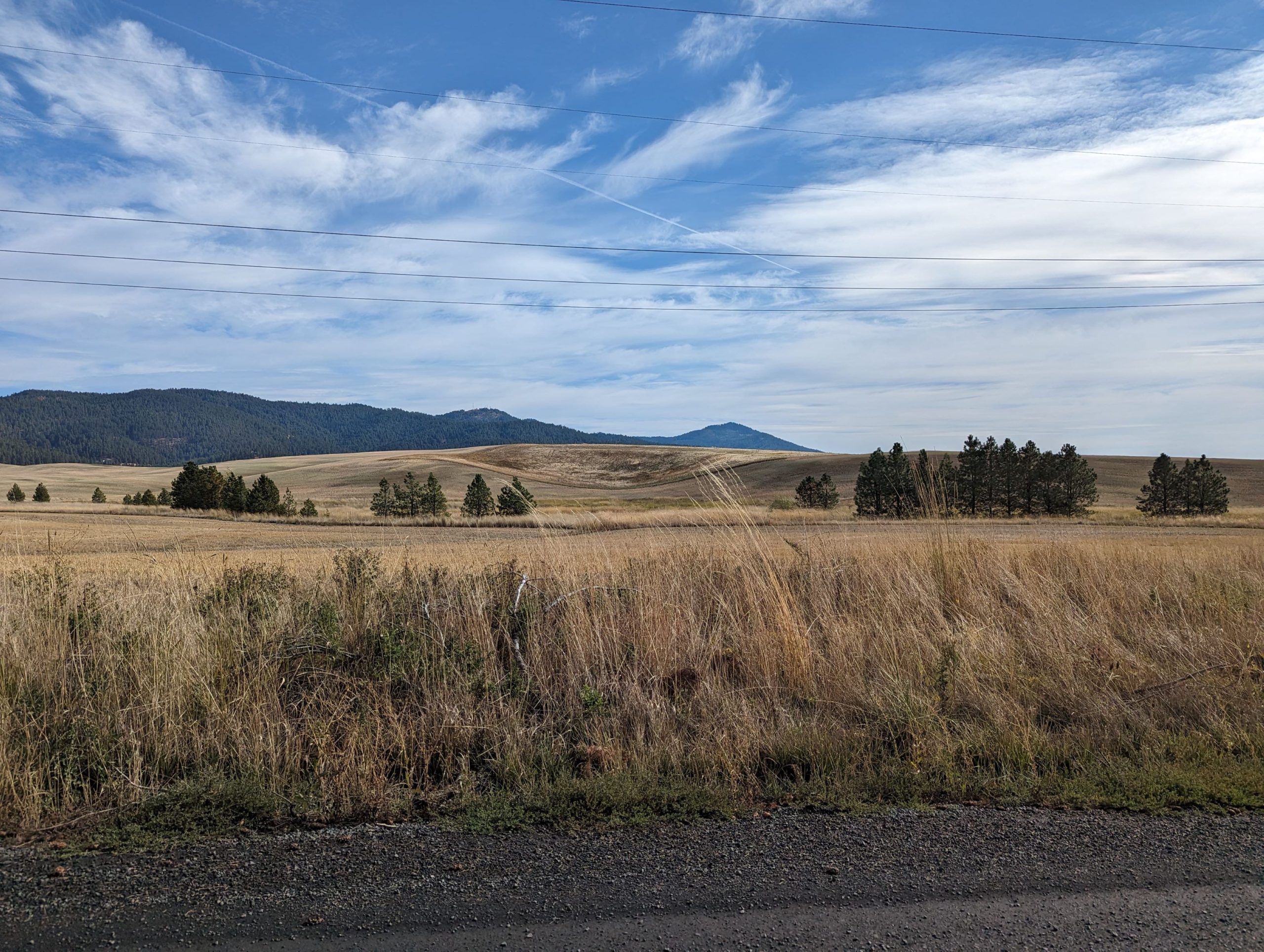
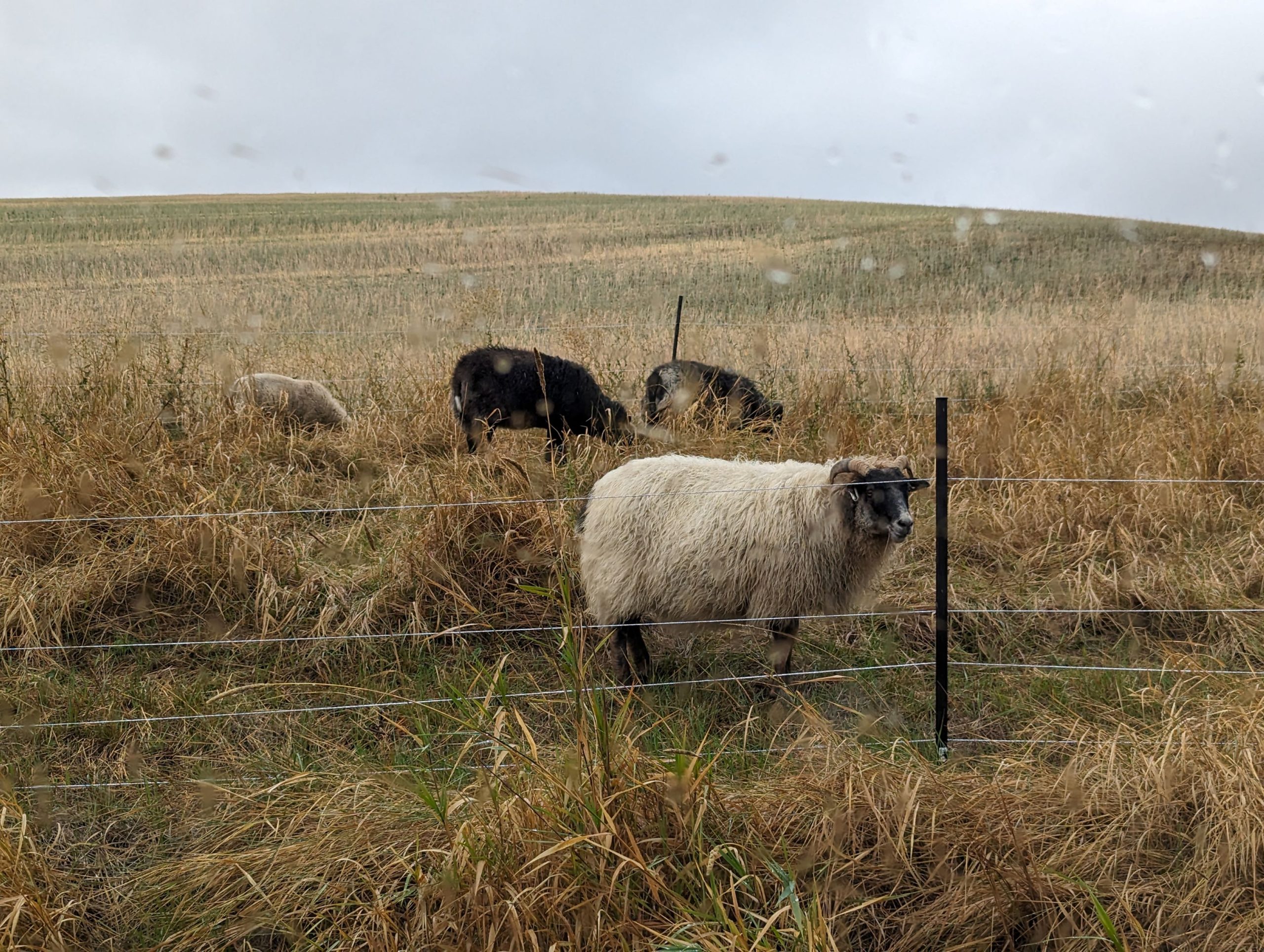
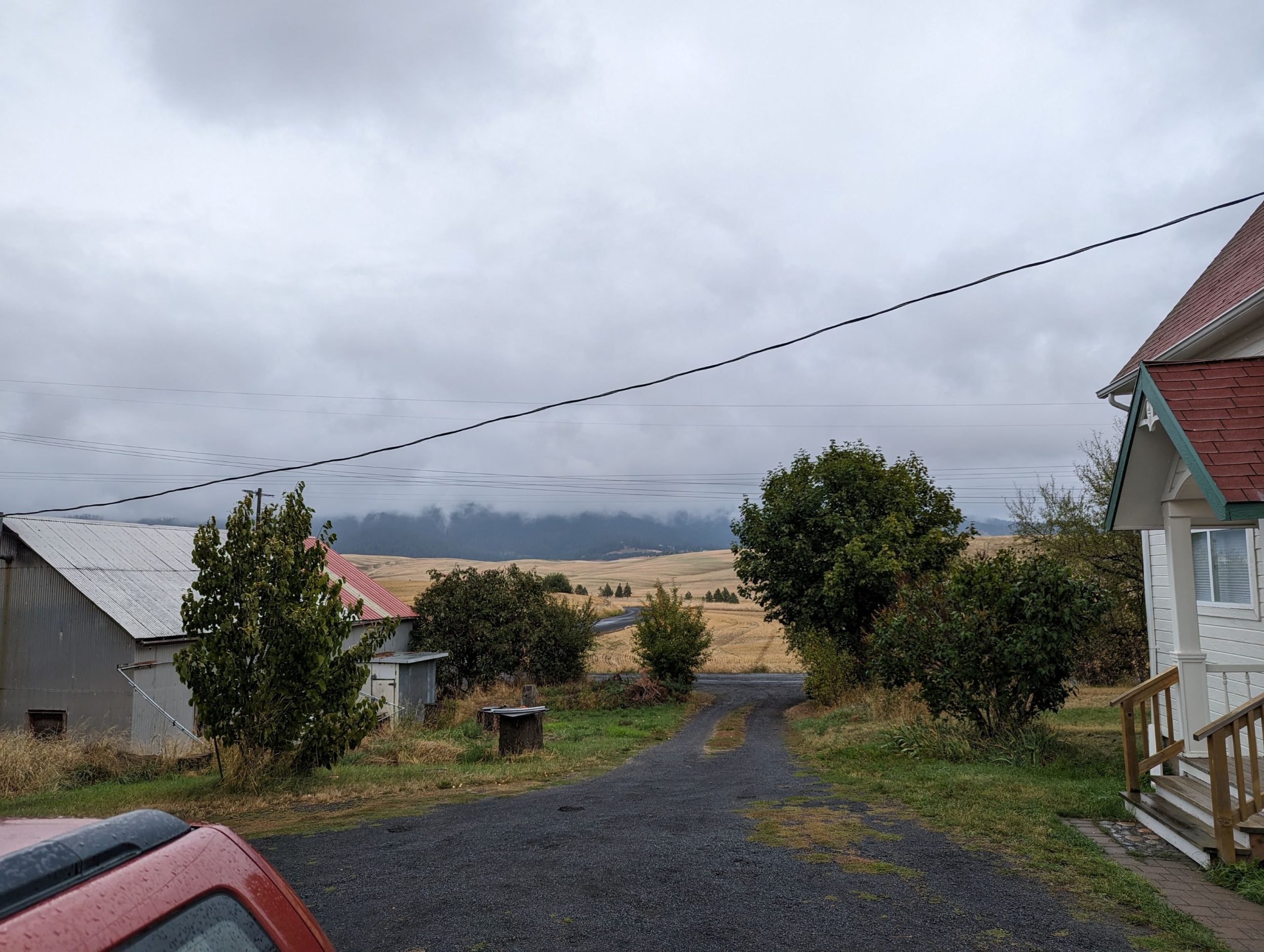
Black cows dot olive- and dun-colored hillsides, as much a permanent feature of the landscape as living creatures. I pass a John Deere tilling soil next to the highway, turning the wheat of a fallow field almost black behind it, and smell the rich dark loam in the air.
A moose appears in a stand of pines just to the left of the road, his coat as dark and wet as the fresh soil, his scraggly antlers carrying the reddish tinge that means he’s still fresh out of velvet. First-week-of-conference antlers. By the time the business end of the season comes around – if he makes it that long – they’ll be as sharp white as the dream-killing frost on the field in Brookings, South Dakota. I put on my blues playlist and roll south to the swish of the windshield wipers and the longing guitar chords of Fenton Robinson and Lightnin’ Hopkins.
Jerek Wolcott texts me as I’m still in my blues trance a few miles north of Moscow. Jerek grew up in and around North Idaho: first in St. Maries, same as Choate, and then across the state line in Libby, Montana. He went to the Kibbie Dome for the first time when he was 12, for an Idaho basketball game against Iona. After going to college at Montana, he worked in the athletic department with the Griz, at Carroll College in Montana, and at Northern Iowa.
“When I started, we were still sending faxes, right? I remember, like, sitting with Dave Guffey (at Montana), and sending faxes of postgame stats out,” Jerek said. “And now it’s so digital.”
With his mustache, stubble and short shock of straight black hair, Jerek looks like a slightly smaller, less-bearded Jason Kelce.
He’s been head of the communications department at Idaho since 2021. In that time, Idaho has built a $700,000 production studio in the basement of its new basketball arena. The Vandals’ Twitter followers have grown from 16,000 to over 27,000.
It’s a rise that mirrors that of the football team – and the athletic department as a whole.
“That’s been an upturn in not only reality, but also in perception, just because of what we’ve done across the board,” Jerek says, sitting in his office overlooking the 140-yard practice field and, further up the hill, old brick Memorial Gymnasium, where Idaho played basketball until the construction of the state-of-the-art ICCU Arena in 2021.
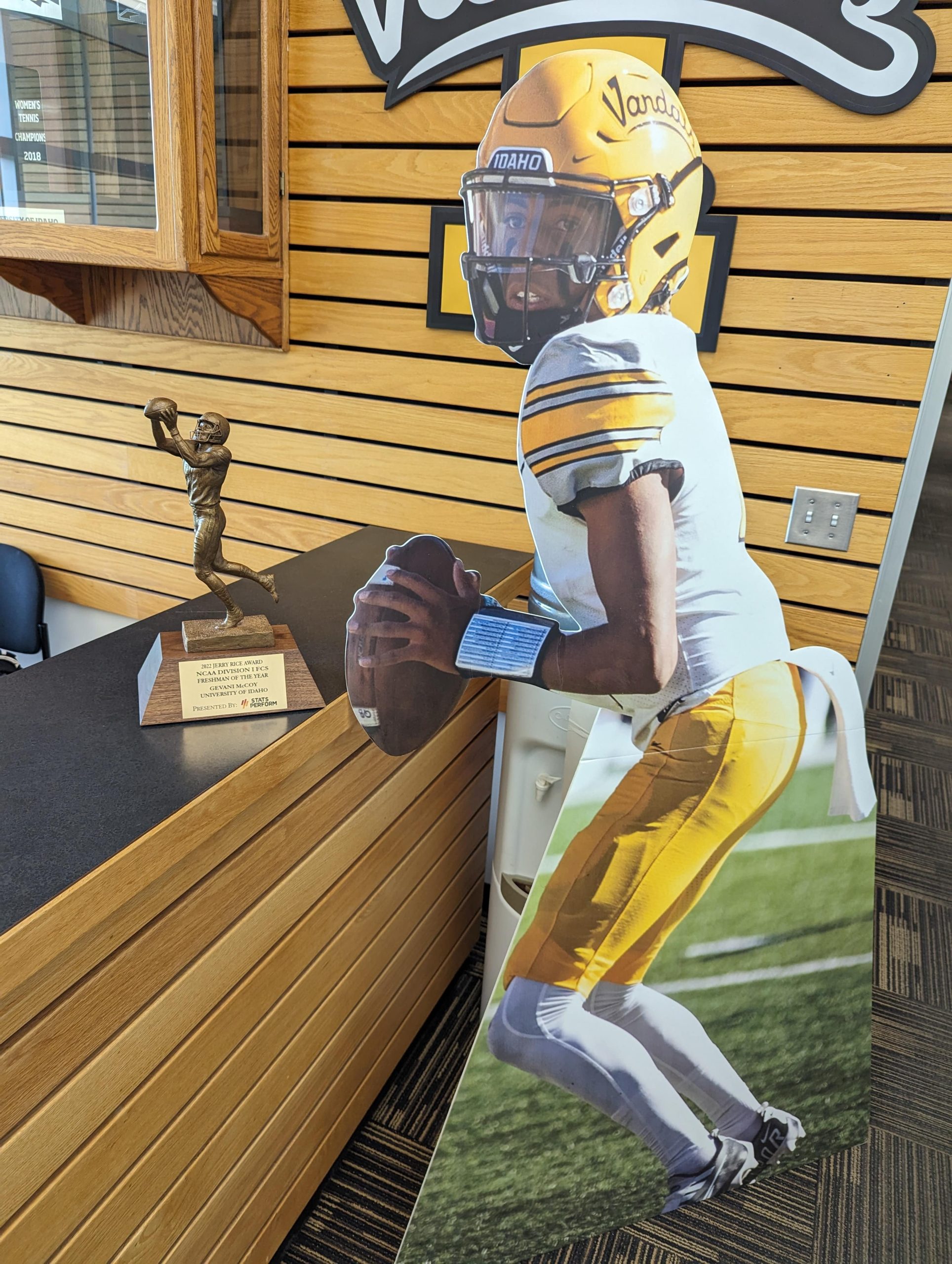
On the way in, he stopped to show me the school’s replica of quarterback Gevani McCoy’s Jerry Rice Award, given for being the best freshman in the FCS in 2022. The trophy had arrived just the day before, and was destined for a case alongside Freisz and Nussmeier’s Payton Awards. For now, it sat on the reception desk, next to a possibly larger-than-life-size cardboard cutout of McCoy, the whippet-thin, smooth-faced, soft-spoken QB from Baldwin Hills in South LA who threw for 2,719 yards and 27 touchdowns last year as a redshirt freshman and was voted a team captain this year.
“If you look at my last place I was at, Northern Iowa, when the basketball team was making Sweet 16 runs and beating Kansas, people across the country were talking about them. Enrollment? Up. Value of the brand? Up,” Jerek says. “It turned into a basketball school. … You look at Carroll, and what happened when they won national championships (in football). That brand went up. They went from being kind of another Frontier (Conference) school to the best regional college in the West, and they had a lot of opportunities there that they wouldn’t have otherwise.”
My visit to Jerek’s office serves two purposes – I want to chat, and he wants to show me around the athletic facilities. After nearly 50 years, there’s still no better descriptor for the Kibbie Dome than a beer can cut in half and stuck in the ground. As always, walking into the Kibbie for the first time after a while is disorienting. It’s an almost unbelievably massive space – 14 stories tall, leaving your mind casting wildly around for something to fill the empty air above the football field.
It’s buzzing even before game day on Friday – the football team is wrapping up practice, and the men’s tennis team is kicking a soccer ball around on the turf.
The Kibbie Dome is just a couple years away from its 50th anniversary – although it officially opened in 1971, it didn’t get the roof until 1975 – and over the years, it’s become an easily recognized symbol of the program. If people across the country know about Idaho football, it’s likely because of the Kibbie Dome – which Jerek doesn’t mind. If that’s the hook they need to promote the program, they’ll do it. Idaho football has been a fixture on social media the last few years, interacting playfully with national college football accounts on Twitter. Last season, they hosted an AMA – Ask Me Anything – with Eck on Reddit, with the coach answering questions like “How many of the Big Sky coaches could you beat in hand-to-hand combat?”
thank you for the care package 🫡 @VandalFootball pic.twitter.com/OXk73SjPNZ
— no context college football (@nocontextcfb) October 3, 2023
“We’ve embraced what we are. We know that we have a goofy stadium that people love for a video game,” Jerek said. “But if we embrace it, and we talk about that, and we join on with the Sickos Committee and let them love us and we love them back, they get excited about it. … We’re embracing the wacky weirdness that we are.”
Just a few steps away from the Kibbie Dome is Idaho’s new basketball arena. Like the Kibbie, it’s got plenty of easy descriptors – someone later in the trip will compare it to the hull of a Viking longship turned upside down – and like the Kibbie, it’s completely unique. Very unlike the Kibbie, which is awesome in all the more literal meanings of that word, the ICCU Arena, opened in 2021, is also legitimately, jaw-droppingly beautiful. Made completely out of wood, with everything but the actual court sourced from local forests (maple, apparently, doesn’t grow well in Idaho), its facade swoops and dives, lines as classic as a ‘64 Mustang.
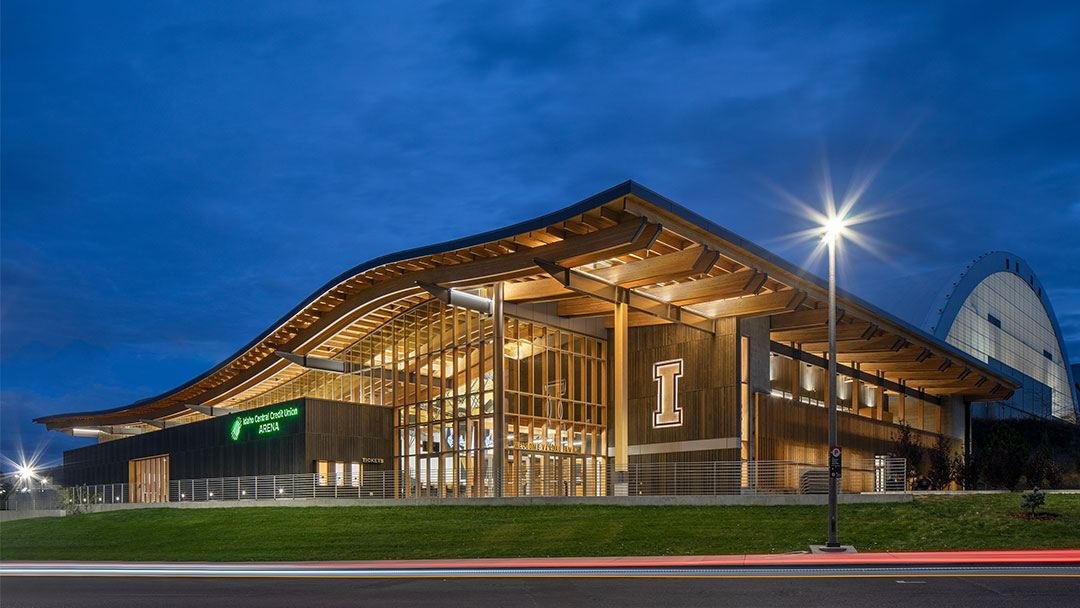
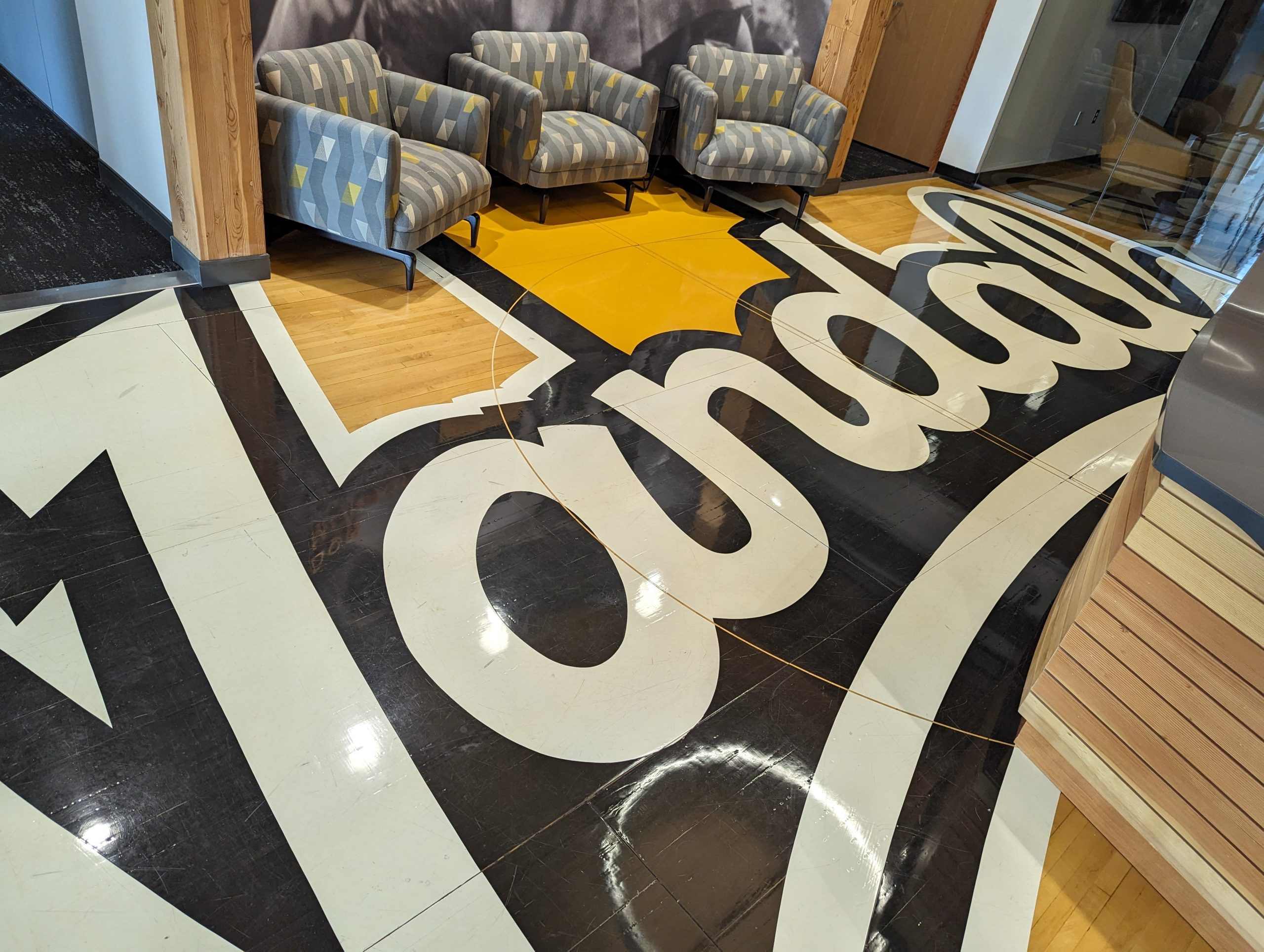
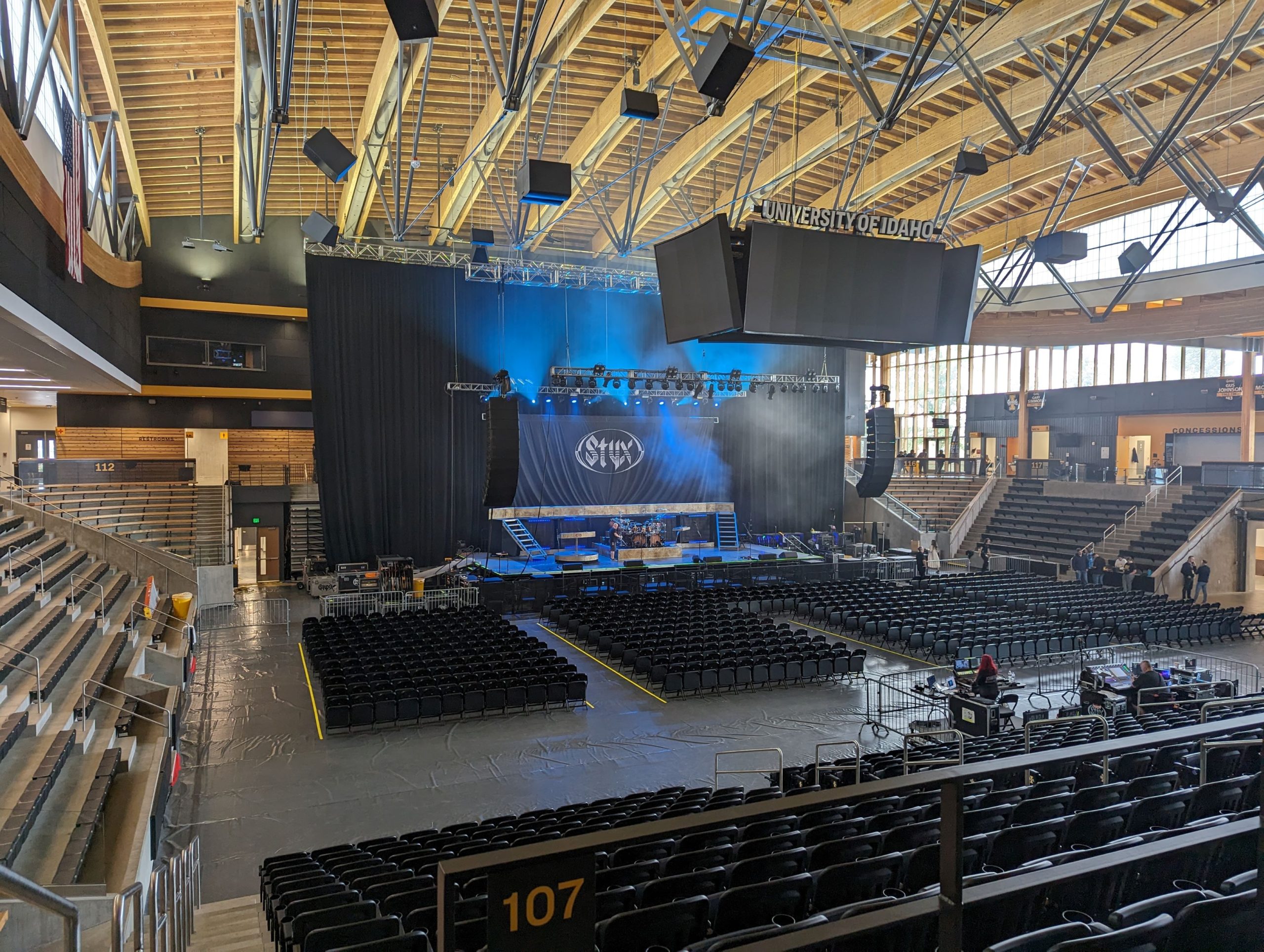
When we visit, they’re setting up for a Styx concert later that night, and the smoke machines are churning, wreathing the stage in gray fog.
It’s my first time inside, and Jerek gives me the full tour – the production room downstairs, covered in monitors and blinking boards; the basketball offices upstairs, floored with the hardwood center-court logo taken out of the old Cowan Spectrum; the full practice court, covered by the bleachers for the night.
Comparing it to historic but tiny Memorial Gym, or the Cowan Spectrum – really the Kibbie Dome dressed up in a different configuration with a basketball court in the middle – is like comparing filet mignon to a ballpark hot dog.
ICCU Arena cost $52 million, funded over the course of multiple decades primarily under the leadership of former athletic director Rob Spear, a Butte native who played hoops at the University of Great Falls. Spear wasn’t around to see the arena built – he was fired in 2018 after a sexual harassment investigation centering on a Vandal football player. But if you’re looking for turning points for Idaho athletics – and people will offer up plenty over the course of my trip – it might be best to start here.
“I’ve never seen a basketball venue like that,” athletic director Terry Gawlik said. “I’ve been around. I’ve been in a lot of venues, as you can imagine. It’s incredible. I mean, everybody loves going into the arena. Every time we’re showing recruits, either where you can play basketball or come watch sports (it’s like), look what we’ve done here. Look how beautiful this is.”
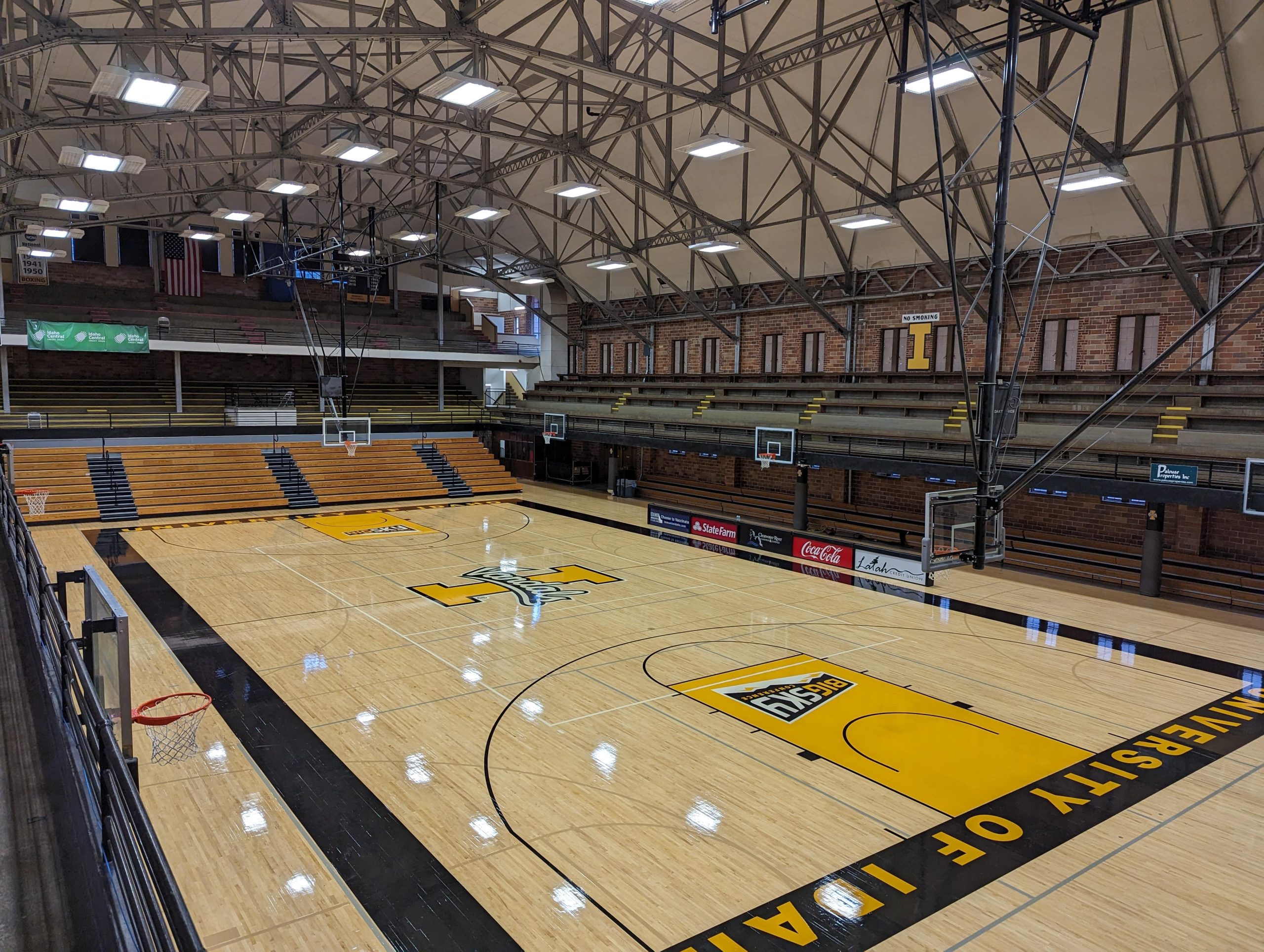
For completeness’s sake, Jerek walks me up the hill to Memorial Gym. It really is a gorgeous old building – just not one that ever should have been hosting Division I basketball in the 21st century.
For better or worse, the awful sightlines and cramped stands in Memorial Gym – perhaps the worst on-stream viewing experience in the league – represented Idaho athletics for years. ICCU Arena is many things – a beautiful arena, a recruiting tool, something for the community to be proud of. It’s also a symbol of what Idaho athletics wants to be, where they want to go.
“When I took this job, and I looked at the history here, the resources that we have, the new basketball arena, I said there’s no reason that we can’t go win a championship,” Jerek said. “I use the word, the same phrase that (Jason Eck) uses, that we’re a sleeping giant. … We have the resources to be excellent. The football team has resources to win a championship, and the same thing with basketball with that arena. We should win Big Sky championships, or be competing for Big Sky championships all the time.”
We leave it there. Jerek has game notes to finish, and a youth football practice to get his son to, and I have another appointment. We shake hands, and I get back in my car and head towards downtown Moscow.
Marc Trivelpiece sits about 10 yards outside the nerve center of Vandals fandom, wearing blue jeans, a Corner Club hoodie and a weathered ballcap with Joe Vandal on it.
At 4:30 p.m. on a Friday, the Club is…well, not packed, but buzzing with an equal mix of college students and what looks like their parents. Marc, like any good bartender, recognizes approximately 80 percent of the people inside – I know this because I ask him later in the evening, and he points them out one by one.
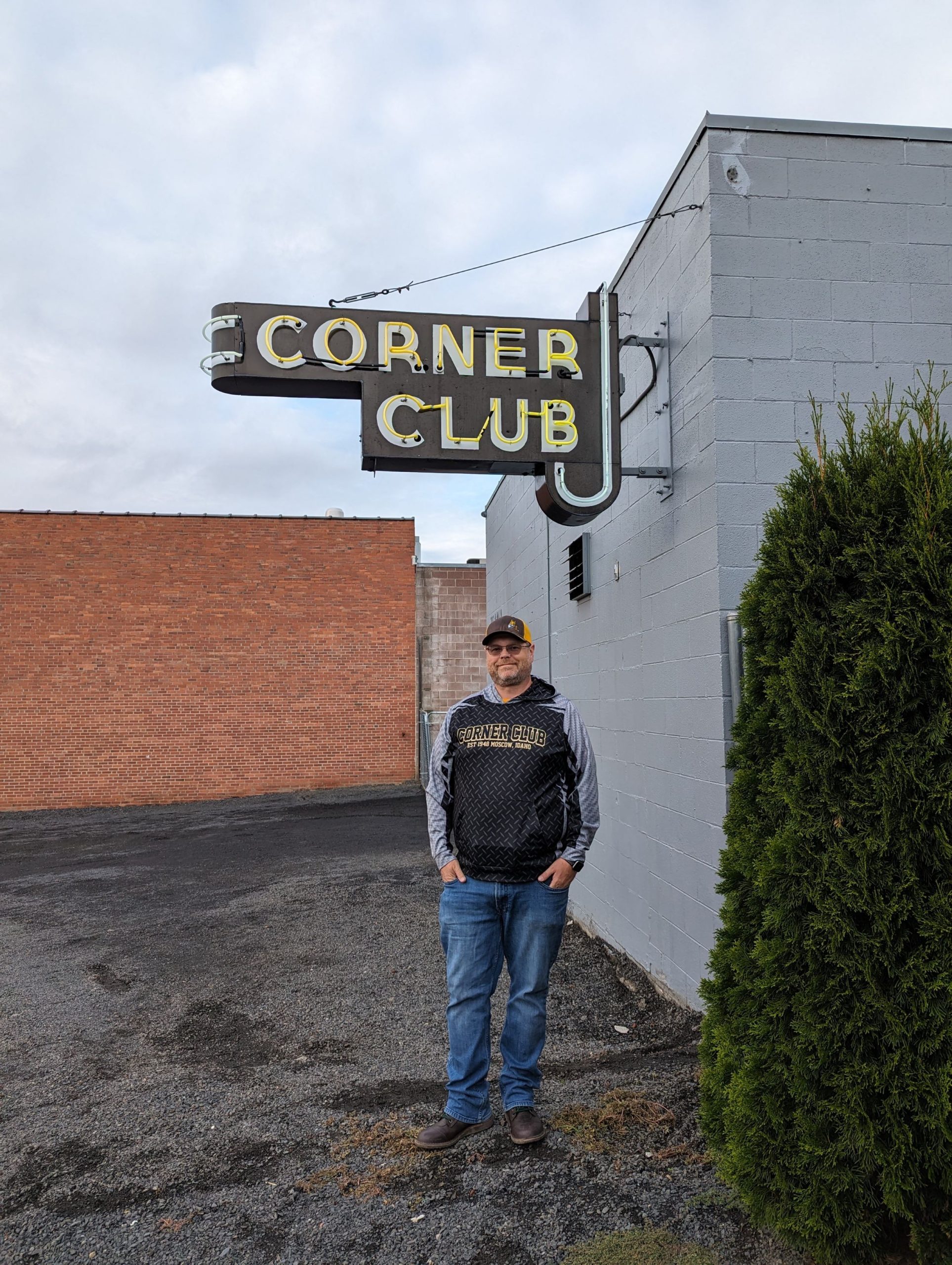
He’s worked at the Club since 1996 and owned it since 2007, when he saw it was for sale and convinced his then-wife to move back to their mutual college town.
He grew up in Palouse, just over the state line in Washington but only about 20 minutes up the road.
“The majority of my graduating class went to WSU, and I was like, I didn’t really want to do that,” Marc said. “So me and two others came over here to the University of Idaho. I graduated high school in 1992. And then I had a lot of fun in college, so I didn’t get out of here until 1999.”
Marc and I commandeer one of the picnic tables outside, him nursing a water and me drinking Pabst Blue Ribbon – a regular pint, not one of the 32-ounce tubs that give the Vandals fan podcast Tubs at the Club its name.
From the outside, the Club is a small, square gray cinderblock building with only a neon sign hanging on the front to distinguish it from an ambitious chest freezer.
Inside, though, it’s both a crowded college bar and a shrine to the tradition of the Idaho Vandals. Baseball has Cooperstown; Idaho has the Corner Club. There are framed jerseys and pictures of past Vandal greats on every square inch of the wall, newspaper front pages of past triumphs trapped under plastic on the tables. Touring the Kibbie Dome and the ICCU Arena gives you a sense of where Idaho athletics is at now, but the tiny, cramped space of the Corner Club tells you where it’s been – and the people who helped blaze that trail.
Like NFL Hall of Famer Jerry Kramer, whose daughter had tears in her eyes when Marc let her know that Corner Club had purchased one of his old college jerseys at auction – and who opened the door himself when Marc went down to Boise to get it signed in person.
Last year around this time, #BigSkyFB Hall of Famer John Friesz came on #NuanezNow for the ESPN Roundtable on @1029ESPN with @Colter_Nuanez on the rivalry between Idaho and Montana. #GrizFB plays at @VandalFootball on Saturdayhttps://t.co/xXTUCNCh6K
— Skyline Sports (@SkylineSportsMT) October 13, 2023
Or Mike Iupati, a first-team All-Pro who played 11 years in the NFL and signs the glass case his jersey is displayed in every time he comes back to the Club.
Or Eddie Williams, the MVP of the 2008 team, who teased Marc about not seeing himself up on the wall before sending the Club one of his Cleveland Browns jerseys that now sits right above the door.
Or David Vobora, a linebacker who was Mr. Irrelevant in the 2008 Draft to the Rams and now helps amputees recover their physical fitness.
Or John Yarno, who gave NFL teams looking to draft him in 1977 the Corner Club’s phone number, then spent the whole day hanging out there before the Seahawks picked him in the fourth round.
“Hopefully I can get a poster up there one day or something,” Idaho’s All-American wide receiver Hayden Hatten told Trevan Pixley of the Lewistown Tribune.
“I’ve been up on the roof working on stuff and you can hear a car pull on the lot and you go peek over to see what local is showing up,” Marc said. “And then you look and you see that it’s a family taking a photo underneath the sign. Those kids can’t come in the bar for, you know, another 15 years, but here they are. It’s just a super-cool unofficial piece of Vandal memorabilia.”
As the evening rolls on at the Club, regulars like Nate Deahn start rolling in. Nate’s got a playoff hockey beard and, hell, he’s big enough that he looks like he might just be a few years removed from grinding on the fourth line for the Blackhawks, too. He met Terry Gawlik when he helped her sand the logs of the house she built in Moscow when she got the AD job, and got to know Marc really well when he helped renovate the entire bar at the Corner Club during COVID.
Later on, I collar Zach Gray, who works in construction – his firm usually hires a Vandals player on for the summer.
“It’s a great sports bar, but it’s also a working man’s bar,” Zach says over the hum of the crowd. “But all mixing with college students and Vandal fans, and all the working class and random fans.”
Like Jerek told me earlier, Northern Idaho is “a lot like Montana, everybody likes to have a good time, drink a few brewskis. Northern Idaho is mining, logging, more of a work-hard, play-hard attitude.”
It’s no wonder the Corner Club – tiny, crowded and alive, by this point in the evening, with probably a hundred people drinking, talking, flirting and yelling, bodying up to the bar and telling stories and getting good and drunk – has become a touchstone of the community.
“Over time, it’s just kind of become a catch-all for everything in town,” Marc says. “Everything from college students to judges to, you know, guys who are pouring concrete. … I just think that it’s kind of a microcosm of Moscow. There’s one rule here, don’t be an asshole. Obviously, there’s a lot of sub-rules underneath that one, but it’s just got that vibe of your parents’ basement, you know, with your dad’s cool memorabilia on the wall. You can cuss in here. Beer is not very expensive. And as long as you’re not an asshole, you’re welcome.”
All that, you feel, makes it the kind of place Jason Eck loves. In under two years, the former South Dakota State offensive coordinator has established himself as one of the best and certainly one of the most recognizable coaches in the conference. A hulking figure – he was an offensive lineman at Wisconsin under Barry Alvarez, and started his coaching career as a grad assistant for the Badgers – he actually coached for three years at Idaho in the mid-2000s, and later at Montana State in 2015. Eck has slicked back hair, a perpetually shiny forehead and an intensely engaging manner. In press conferences, he alternately sprawls back in his chair and then leans forward, drawing you closer, capturing your attention.
In an alternate universe, you could imagine him pulling the same trick as he holds court and drinks Kokanee on one end of the bar at the Corner Club.

Instead, on this night, he’ll have to settle for being the name on everyone’s tongue.
What’s the difference, I ask, between now and the last five years?
“When Jason Eck got hired, there was excitement because he has Vandal roots,” Marc said. “He has a son that was born here. He’s got two kids going to college here. His wife (Kimberly) is amazing. She came in and instantly was like, ‘Let’s do this. Let’s rebuild this culture.’ And they have both embraced Moscow and embraced the University of Idaho, like nobody I’ve ever seen.”
Spending time in the Corner Club, you realize why that’s important. The memorabilia on the wall is a museum exhibit of how much the Idaho Vandals mean to people, and the constant stream of customers in and out is a reminder of just how many people care. They know that there’s a bigger program eight miles up the road in Pullman with Washington State. They’ve watched over the past two decades as Boise State – their oldest, most venomous rival – jumped to the FBS, became a national Cinderella story and then haughtily left them behind, with former BSU president Bob Kustra dismissing the Vandals as “nasty” and “inebriated” in 2010 when explaining the decision to no longer travel to Moscow for the rivalry game. But, like Marc when he graduated high school, they didn’t give their loyalty to the Cougars. They didn’t switch allegiances to the Broncos when Chris Peterson, Kellen Moore and the blue turf put Boise State – and the entire state of Idaho – on the national college football map. They’ll always be Vandals. They want their own history and accomplishments to be recognized, and more than anything, they want that loyalty to be seen, to be acknowledged and returned.
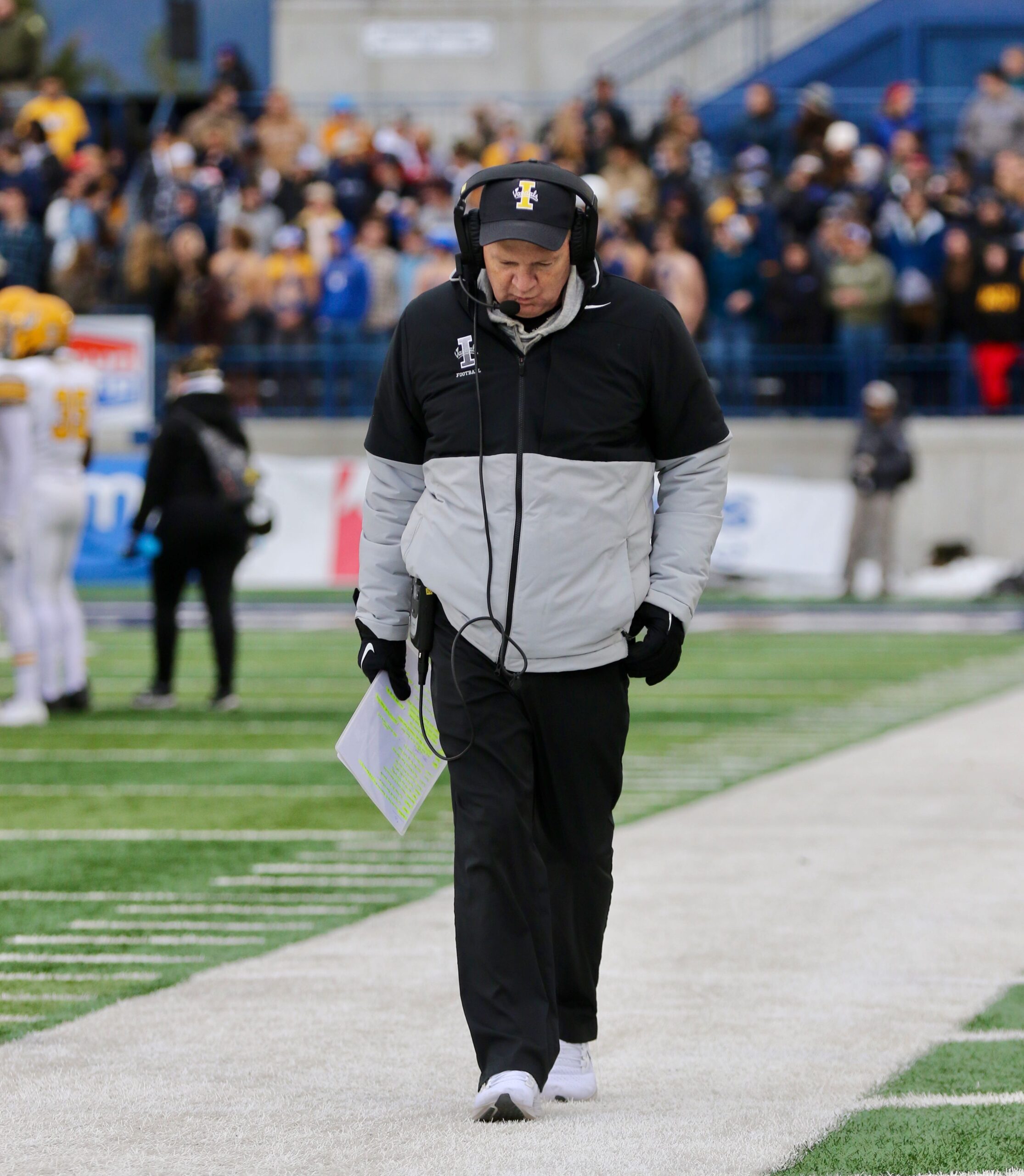
That’s why everybody I talk to at the Club, unprompted, mentions how much they hated that Paul Petrino, for his entire nine-year tenure as Idaho head coach, lived across the state line in Pullman. Even more than the mediocrity – Petrino coached exactly 100 games at Idaho, and won 34 of them – that was unforgivable. It stung.
“When Petrino was here, he lived in Pullman,” Zach Gray said. “He lived in a different state. And it rubbed people wrong.”
“A lot of people took that personally,” Marc said. “That turned a lot of the fans off, and it got to the point where we didn’t really have to prepare for regular home game weekends. We really only had to prepare for homecoming because we didn’t get a lot of alumni coming back.”
Throughout the night, people tell me that they love how Eck and his staff are making an effort to recruit Idaho. How that staff, with Eck’s SDSU protege Luke Schleusner, former South Dakota defensive coordinator Rob Aurich and others, is packed full of talent. How his riverboat-gambler onside kick to start the second half against Montana last year showed guts and belief in his players. How he’s taken players that arrived under the previous staff and turned them into all-conference talents.
But they always come back to the same thing – Jason Eck respects the program. He wants to be in Moscow, coaching the Idaho Vandals – and what’s more, he takes the time to show it.
“My brother and I, we’ve always been Vandal boosters, and when Petrino was here, it kind of turned off. No one wanted to donate,” Zach Gray said. “So coach Eck came, and he reached out to me. … ‘Hey, your company used to be a Vandal booster, used to play in the golf tournament. Would you guys be interested in doing it?’ Absolutely. So we donated a bunch of money, played in the golf tournament, and Coach Eck came up and said, ‘Hey, I’m so glad you guys are back. We all remember you guys. Thanks.’ And that’s what was missing.”
“He’s just a really, really good, genuine guy, and takes the time to say hi to everybody,” Marc said. “He could be deep in conversation, and if a fan comes up and says hi, he will take that second. He’ll take that second to say, ‘Hey, how are you? Go Vandals. Great to have you here.’ And it makes people feel included and special.”
And they’re winning.
“That always helps.”
I finish my beer. Marc’s passing out the new shipment of Corner Club hoodies that came in earlier to his staff, and to people buying them right over the bar. It’s getting late, and college kids are starting to tip the scales of the population inside the bar. I say goodbyes – shouted in ears over what’s now less a buzz and more a general din – and head back to the AirBnb to sleep.
Game day dawns bright and clear, flags snapping in the blue sky above the RVs parked in the tailgate lot.
I wander around for a while – strolling up the hill to the stadium with the extended family of backup defensive end Dallas Afalava – before eventually washing up with Colin Scott Hughes and his family at their RV, where we talk, drink a beer and watch Florida State close out Clemson.
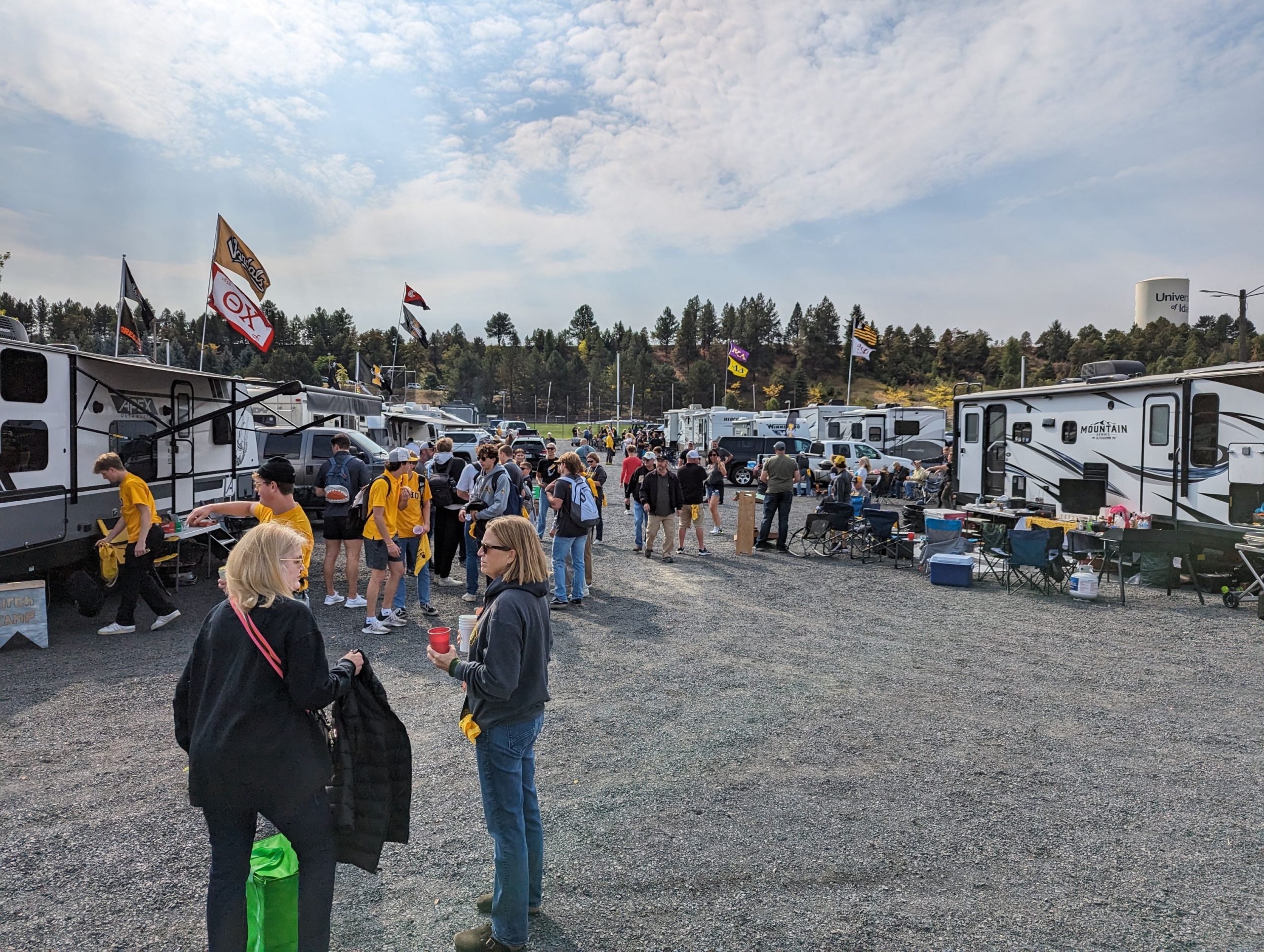
Colin lives in Lolo, Montana, but has Idaho roots going back generations. His grandfather was the dean of the College of Agriculture. His dad, who was a Tau Kappa Epsilon, played football for the Vandals, which is where he met Colin’s mom, a Pi Beta Phi.
“When I was growing up, my dad, when we finally pushed him to the edge, he would be like, ‘It’s bedtime on the Palouse for all of us Vandal fans.’ And that meant, get your ass in bed,” Colin said. “We were a huge, huge Vandal family.”
He also ended up in Moscow, where he and his brother were both Deltas.
Those roots have kept him steady through, as he describes it, “constant letdown for most of my Vandal fandom” and “sporadic success with a lot of brutal seasons.”
“But we were in the parking lot, having fun and going to the games anyway,” Colin says.
He’s the kind of fan who, on vacation in Italy last year, found a TV in the middle of the night to watch Idaho beat the Griz.
The difference is, this year he and the rest of the die-hards have been joined in the tailgate lot by RVs he hasn’t seen in years, or new ones he doesn’t recognize at all.
“The fan base is a 180 from three years ago. I mean, there were times when we literally felt like some of the only people in the tailgate,” Colin said. “And you’d walk in and there’d be 4,000 people in the Dome. It was brutal. It felt like a joke.”
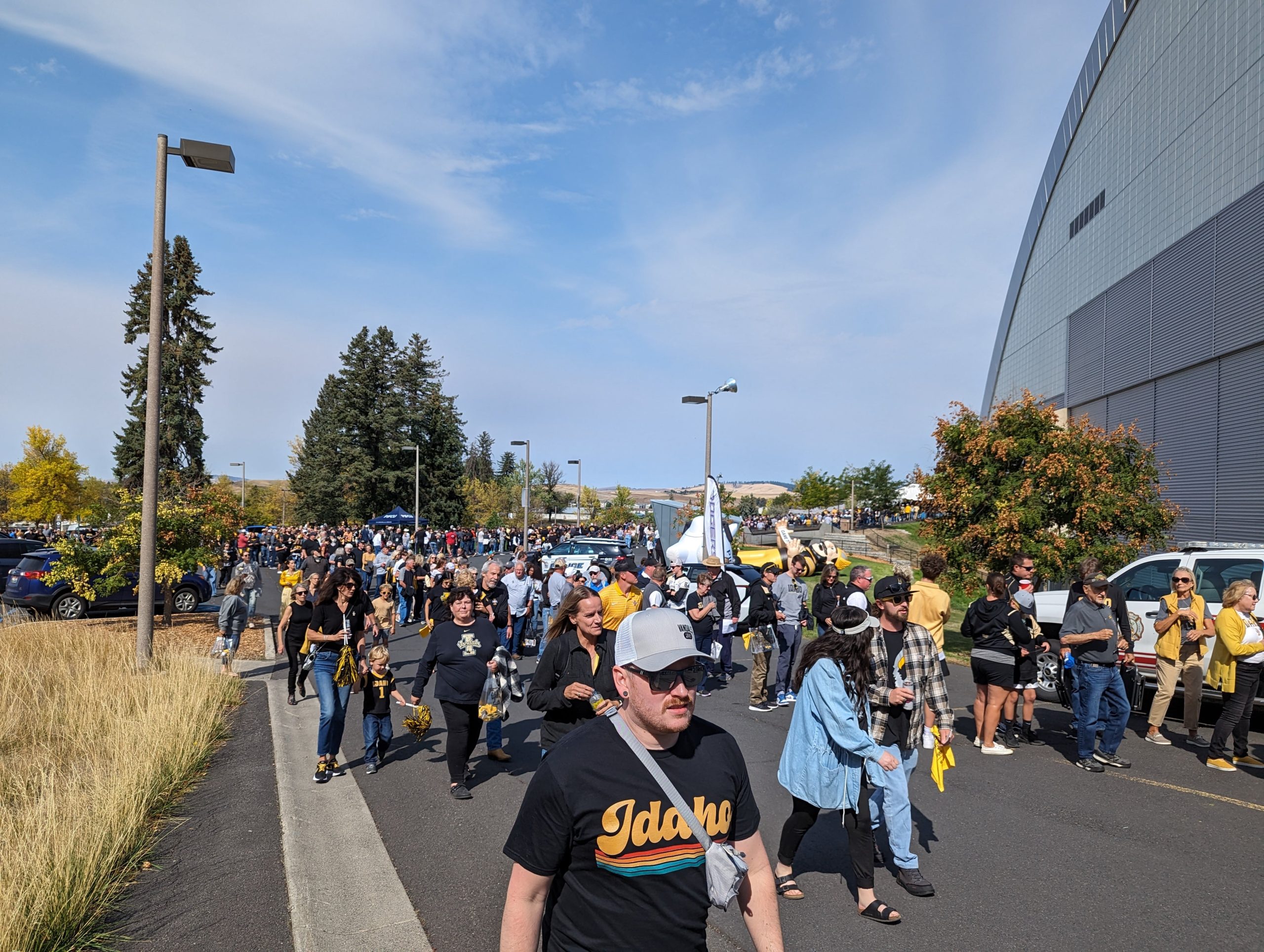
Mike Mai has his own thoughts on the reasons why fans are flocking back to the program like swallows to Capistrano in the spring. Mike is a tall guy in a goldenrod Vandals pullover. He grew up in Burley, Idaho, down near Twin Falls, and remembers his first Vandal game when he was 9, in enemy territory in Boise, watching Boise State running back Cedric Minter score again and again.
Mike’s got a little politician in him, a lot of eye contact and repeating first names. The first thing he does when I head over to his prime tailgating location at spot #39, just a few Gevani McCoy deep bombs down the hill from the Kibbie Dome gates, is offer me a brat and a beer. He has to step away from our 15-minute conversation three or four times to offer people beer, hugs, handshakes or just a wave.
He wants to go all the way back to the decision to drop back down to the FCS in 2018, a move that he and a lot of other boosters and fans were strongly against. At the time, Mike remembered, the program was not well-funded – they couldn’t even fund the full FBS limit of 85 scholarships. Now they wanted to lose the huge chunk of revenue that came from FBS TV payouts? Plus, in an era when their former FCS rivals – schools like Appalachian State and, soon, James Madison, were making the FCS-to-FBS jump and having success, the Vandals would be the first-ever school to make the drop back down in competition, a permanent stain on the program’s reputation.
“I actually sent Chuck Staben, the old president, a note when he announced he was taking us down, because you will not find a guy that was more staunch “stay FBS” than me,” Mike said. “When you looked at Idaho’s athletic budgets, and if you removed all (the FBS money), I mean, it put us 10th or 11th in the Big Sky. We weren’t funded well, we really weren’t. And there were also some people – and I’m not gonna say I disagreed with this – there were some people who were worried about what it would do versus Boise (State) for this university’s standing in the state.”
That move was announced in 2016. In 2018, when it actually took place, things were even bleaker. Athletic director Rob Spear was fired in mid-August, two weeks before the Vandals took the field as an FCS team for the first time in 20 years – a 79-13 loss at Fresno State. University president Staben himself was a lame duck, with the board already having decided not to bring him back at the end of the year.
The Vandals won just three Big Sky games, got blown out by old rivals Idaho State (a 62-28 whomping in which ISU quarterback Tanner Gueller had nearly *600* yards of offense and the Bengals had three different receivers go over 100 yards, with Michael Dean catching four touchdowns) and Montana, and – insult to injury – had to limp down to Gainesville the week after the Montana game to get blown out 63-10 by Florida in their season finale.
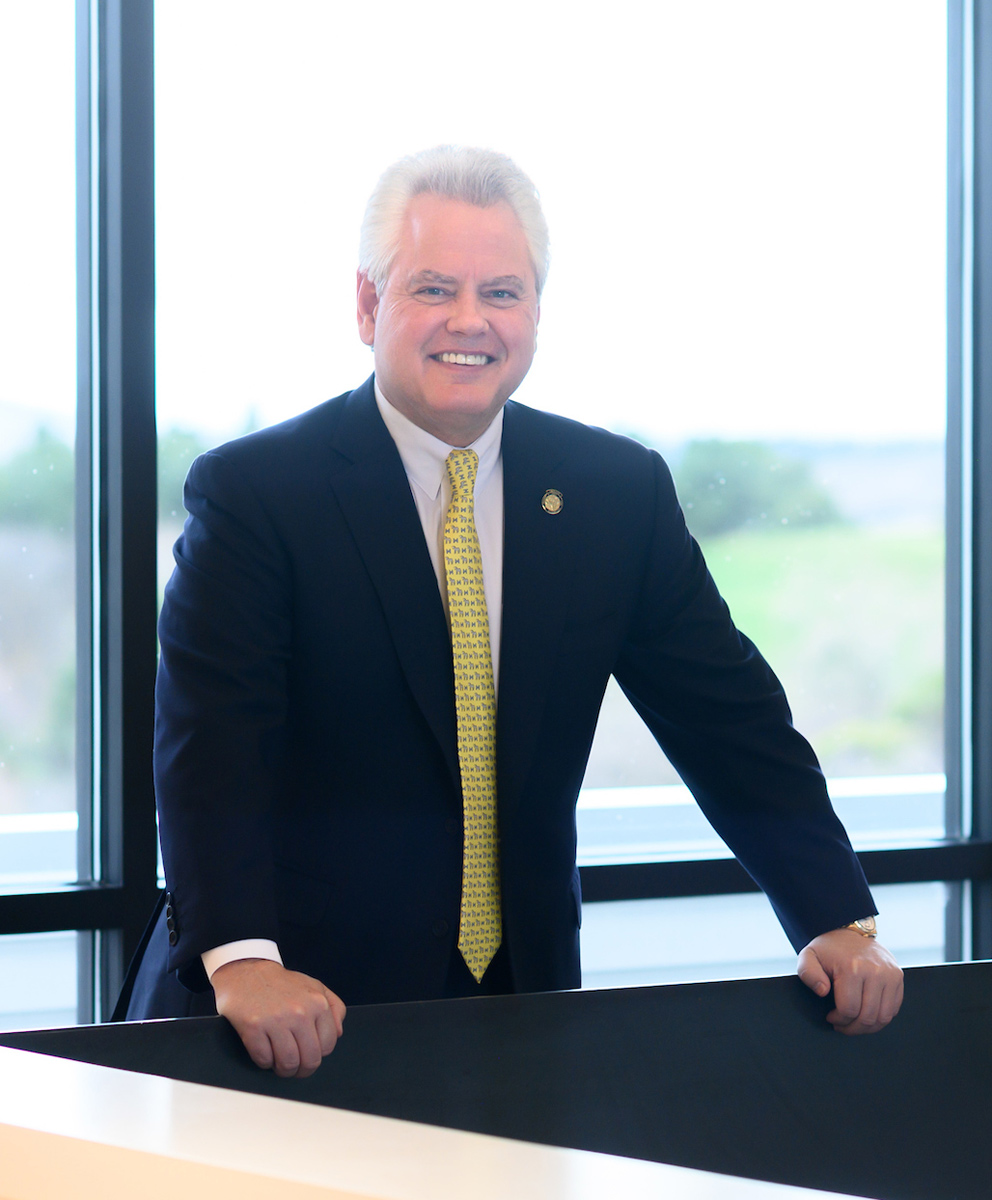
But although it was hard to believe, those lean years were already laying a foundation for the future. To replace the aloof, bookish Staben – a biology professor originally from Waukegan, Illinois – Idaho hired Scott Green. Born in Moscow, Green was a third-generation Vandal who graduated from UI before going to Harvard Business School.
“You get a new president in here, it gets everybody invigorated,” Mike Mai said. “Fundraising has shot up everywhere, and not just in athletics. I think they raised $50-something million dollars last year, something like that, for the whole university as a whole. And so it has changed everything about this place. It all starts with leadership, leadership matters. And Scott has changed everything about people’s attitudes here.”
“Like Jason Eck is sort of the anti-Paul Petrino, Scott Green’s been the anti-Chuck Staben,” Brian Marceau of the Tubs at the Club podcast said. “One of the first things that Green did during his first football season was make sure there were some pictures and video of him tailgating in the parking lot. … Financially, Scott Green has been a huge deal. The University of Idaho’s bottom line has improved quite a bit.”
With the sexual harassment scandal that led to Spear’s firing still fresh, Green hired Gawlik, a senior associate athletic director at Wisconsin who oversaw the Badgers’ Title IX compliance.
The experienced administrator – she’d been at Wisconsin since 1994 – faced waves of initial pushback from boosters, primarily over her refusal to can embattled men’s basketball coach Zac Claus, who went a hard-to-believe 28-88 over four seasons from 2019-20 to 2022-23.
“I didn’t think she cared enough about winning in our basketball program,” Mike Mai said bluntly as kickoff approached, people streaming past his tailgate towards the Dome. “But, I will say this. That’s not the case now. … She’s done an amazing job in saying, this isn’t a one-year rebuild. They’ve had the patience to do that, even when they’ve had impatient guys like me who want them to do it now. And because of that, they’ve been extremely successful.”
Time will tell if Gawlik’s offseason hires of Alex Pribble to replace Claus and Carrie Eighmey as head coach of the traditionally successful women’s basketball team pay off as well as her hiring of Eck, who she had prior connections to from Wisconsin.
That’s a discussion for the winter, though, and on a beautiful fall day with kickoff rapidly approaching, it seems very far away.
“You know, I wouldn’t support us going up (to the FBS) anymore,” Mike Mai reflects as we pack up and head towards the Dome. “I’m super happy with where we’re at, and it’s been super fun. And I expect it to continue, honestly.”
All weekend, I’ve been searching for reasons behind Idaho’s resurgence, talking to people, getting history lessons, learning their stories. But the easiest answer I find, one that doesn’t require any of that, comes in the Kibbie Dome on Saturday, and it doesn’t take long to pick up on – on the field, this Idaho team is pure fun.
The Vandals are an outward expression of Eck’s outgoing personality, built to appeal to casuals who can barely name a single player as much as the Corner Club regulars and football junkies I’ve been talking to who can remember every peak and valley over the last three decades. They don’t grind out wins. They take risks. And they have a cadre of recognizable, approachable stars.
There’s McCoy, the walking magic trick of a quarterback. Eck said he gained a few pounds in the offseason, but it’s impossible to tell. He has a long windup, and it doesn’t look like he can throw the ball 20 yards. But on the run from a good Sac State pass rush all game, every throw is on target and almost preternaturally on time, a succession of rabbits pulled from top hats.
He has the benefit of throwing to Hayden Hatten, Jermaine Jackson and Terez Traynor. The first two were all-conference studs last season, with both going over 1,000 yards. Traynor was all-conference two years ago before missing most of 2022 with an injury. Like Hatten, he’s big and lanky, 6-3 and 205 pounds. Those two Moss defensive backs. Jackson, 5-7 and just 170 pounds, either runs past them for deep balls or catches quick hitters out of the slot and scoots around them. Last season, Hatten was the best receiver in the country – 83 catches, 1,209 yards, 16 touchdowns.
Against Montana, he had nine catches for 149 yards and two touchdowns to lead the Vandals to a 30-23 win at Washington-Grizzly Stadium. He also celebrated his second score, a 43-yarder he snatched off the top of Corbin Walker’s head, by busting out Cristiano Ronaldo’s iconic celebration in front of the north end zone, and then said about the win in the postgame press conference, “I knew it was going to happen.”
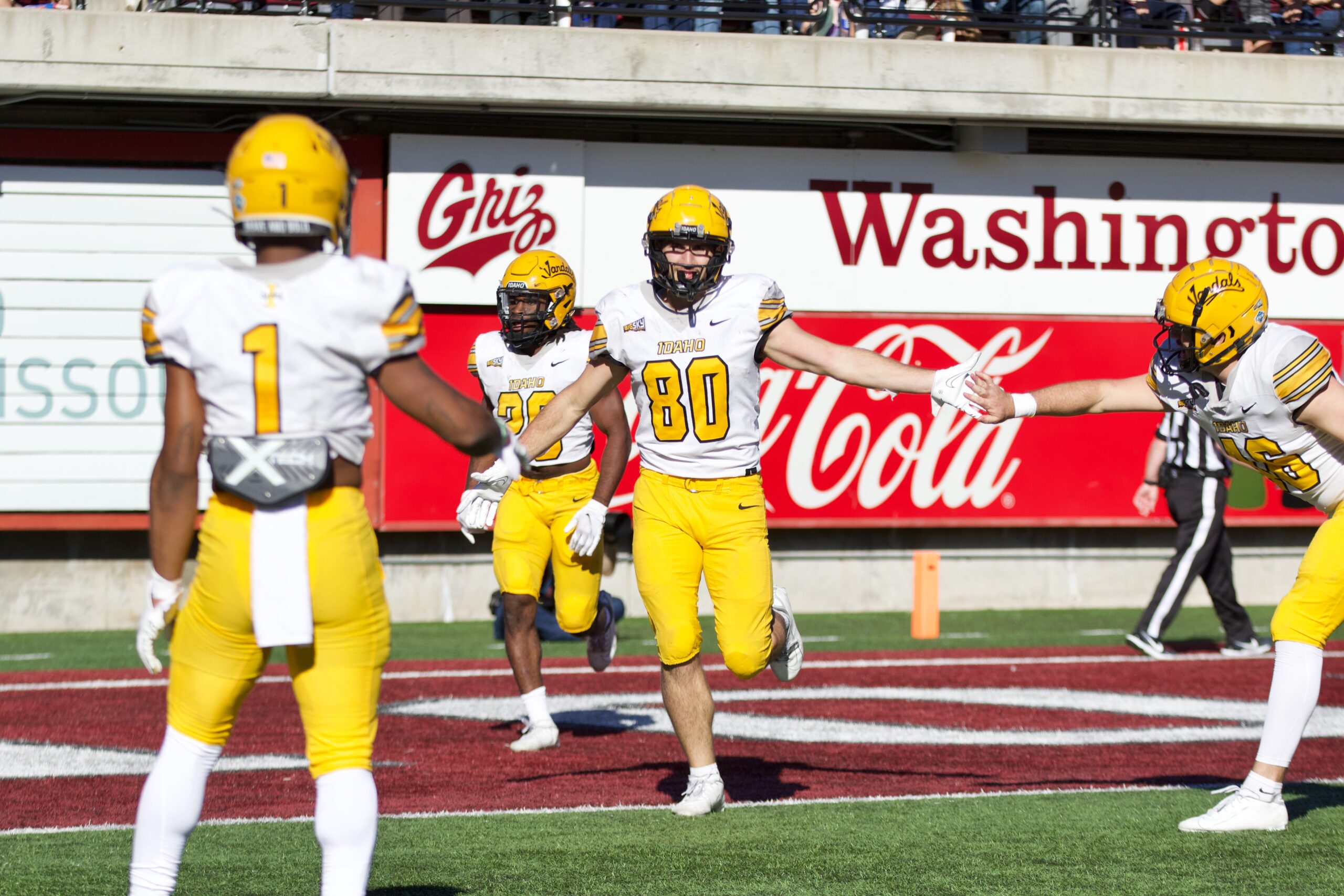
“We went to the game and all of a sudden, here’s Hayden Hatten catching a 50-yard bomb standing in that north end zone with a sea of maroon shirts,” Mike Mai said. “And I’m like, how could you not love this?”
A fast-talking, charismatic business major from Arizona, Hatten’s still a cheat code, an NFL-ready blend of physicality, route-running savvy and flypaper hands.
On one play in the first half against Sacramento State, McCoy, a righty, rolled out left with only Hatten on that side of the field, and no other options besides getting it to Hatten or taking off and running. No problem. At the top of his route, Hatten subtly leaned a shoulder into his defender, just enough to nudge him a half-step off balance, then stopped and turned to catch a perfectly-thrown ball.
This year, the Vandals’ sophomore running back Anthony Woods has joined Hatten on that tier of stardom. Woods, a quicksilver bruiser from Palmdale, California, went on to follow up his 117 yards against Sac State with 211 yards and five touchdowns against Eastern Washington the next week, and currently sits seventh in the FCS in yards per game. Heck, even Chavez, the kicker, isn’t boring, punting with his left foot and kicking with his right – a trick he learned as a soccer goalkeeper growing up in LA.
“The last two years of Vandal football have been fun at a level I have never experienced as a Vandal,” Brian Marceau said. “Way more fun to me than either of the bowl seasons.”
With Idaho up 13-10 in the third quarter after a slow first half against Sac State, McCoy handed off to Woods, who pitched back to Jackson cutting into the backfield. He tossed it back to McCoy, who threw it deep up the right sideline to transfer tight end Turon Ivy Jr. for a bobbling catch and a 50-yard touchdown.
“Yeah, that one, we call it Anchorman,” Eck said after the game in a 30-second soundbite that perfectly encapsulates his glib, entertaining gunslinger personality. “(Tight ends coach Tyler) Sutton brought that from University of San Diego. I kind of call them elements because they’re elements of your offense but they can be explosive, highly explosive like hydrogen or something. I told them right in the headphones before the game, let’s get some of those called. Let’s not leave bullets in the holster.”
A couple possessions later, McCoy went deep down the same sideline to Traynor, who hauled in the 60-yard bomb for his first touchdown since that 2021 season.
Less than a minute left in the third quarter, McCoy goes deep for Terez Traynor, Traynor does the rest and the crowd goes crazy. Idaho up 27-17 at the end of three. Great game in Moscow. pic.twitter.com/gtqxSvGSVb
— Andrew Houghton (@AndrewH202) September 23, 2023
With Idaho driving for the go-ahead score in the final minutes after a big kick return from Jackson, Woods took a handoff right and immediately got corralled by a wall of five defenders. With the ease of someone walking down the street, he broke out of an ankle tackle, dismissed another defender with a casual swat and reversed field for 19 yards to all but seal the game. Two minutes later, Chavez knocked through the winning kick.
Minutes after that, McCoy strutted onto the field with the marching band, absurdly and joyously waving a fake conductor’s baton as they serenaded the student section.
It's gonna be a party in Moscow tonight pic.twitter.com/NPBJFmGQRI
— Andrew Houghton (@AndrewH202) September 24, 2023
Walking through the tunnel, teammates screamed deliriously at Chavez as he waited to go into the press conference.
Game winnerrrrrrrrr!
Hogan Hatten, Hayden’s twin brother and the long snapper, spotted Lola Eck in the tunnel, bent down to the 6-year-old’s eye level, and told her, with mock seriousness, “See, Lola? That’s why you need a good long snapper.”
It’s all a contrast to – and I told myself I wouldn’t make this comparison, but screw it – the atmosphere at places like Montana, where the weight and expectations of decades of success have settled on the program like a crust of barnacles, turning, it seems, even the act of winning into a dour, joyless experience.
Winning is fun, Bobby Hauck is fond of saying, emphasizing “winning” as though nothing else could possibly be. And it is. But so is everything that goes along with it. And at Idaho, where 20 years of mostly futility have ensured that winning isn’t taken for granted, that’s easy to see.
“It was fun to go sing the fight song and have ‘Vani up there conducting in front of our band,” Eck said. “I really thought our student section was awesome today.”
By Saturday night, hours after the final whistle, the college students have, finally, completely taken over the Corner Club. Marc’s checking IDs at the front door. Inside, it’s a festival of exaggerated body language, the chin-forward, tilted-head conversations that are the only way to communicate over the music, kids nodding and swaying to Lil Wayne and Drake and, yes, the reverberating, oscillating bass of Usher’s “Love In This Club, Pt. II” (which, I’ll be honest, I’ve kind of always wanted to hear at the Corner Club).
At least one of the Hatten twins is in the middle of the crowd, graciously swiveling his head to try to respond to or at least acknowledge each new shouted congratulations.
It’s a nice contrast to the eerie, alien quiet of the empty Kibbie Dome, where I stayed late writing game stories, but eight years after college and on the tail end of a 12-hour day, I can only take so much. After one beer, I slip out the back door.
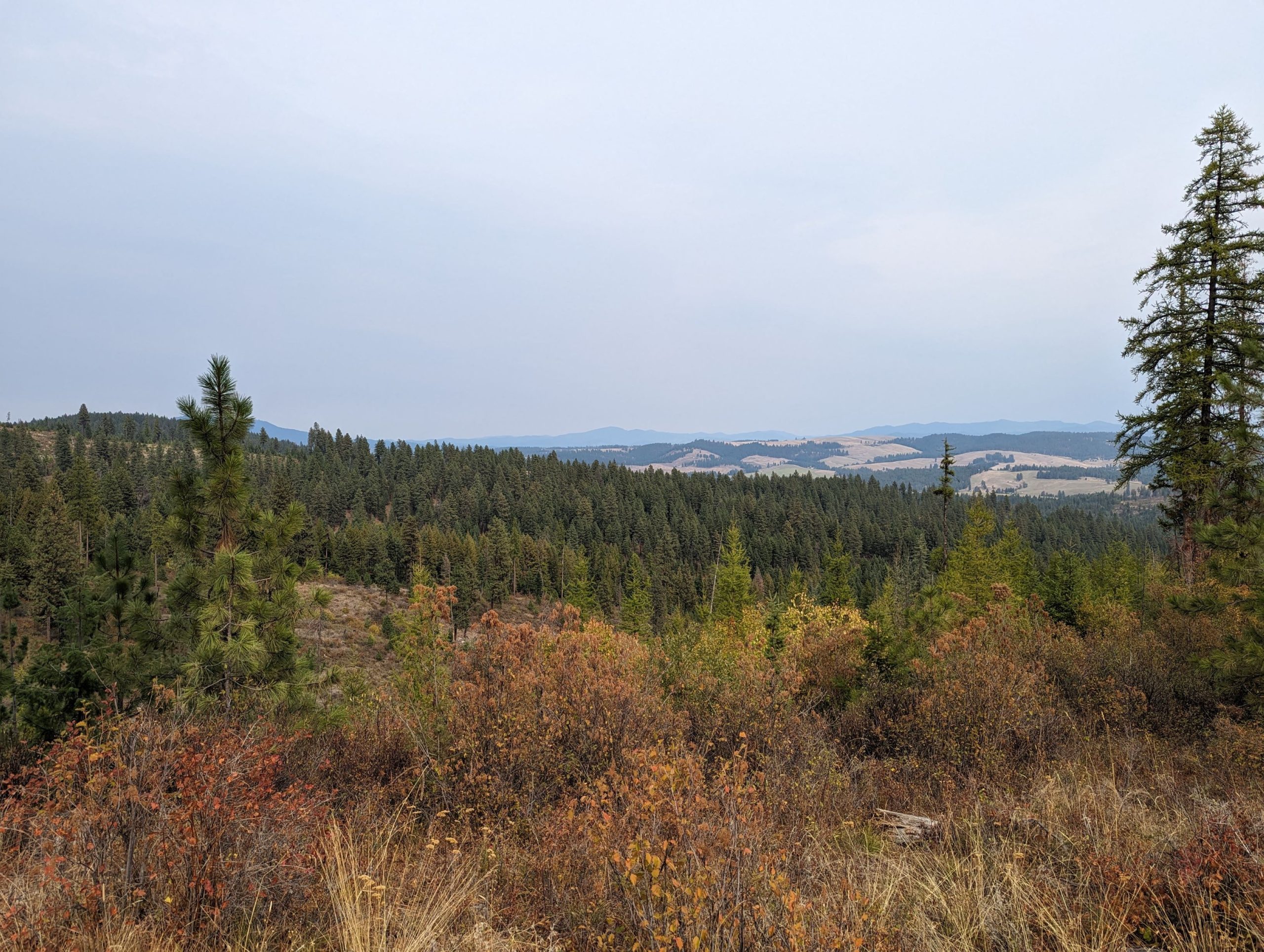
Late Sunday morning, I drive up Moscow Mountain. Standing out on a rocky ridgeline with the Palouse laid out like a patchwork quilt stretching to the horizon, I catch my breath and try to put my thoughts in order. Then it’s time to go, chasing fields of sunflowers and wild roses back to the valley.
Back in Missoula, I call someone who I hope can help me tie everything together. Terry Gawlik, of course, speaks like an administrator, although she was actually a coach for years in her home state of Texas – volleyball and basketball. She started as an event coordinator at Wisconsin, but was promoted to assistant and then associate athletic director.

Idaho is her first time in charge of an athletic department.
“Right now, at this point in time, people are excited beyond belief,” Gawlik said. “Engage with people, you know, that’s what they asked me to do when I came here. That’s what I did.”
Sometimes, it really is that simple. Sometimes – and some places – it all comes together. A history. A coach. A president. An athletic director, and an athletic department. A town. A team.
Jason Eck and Jerek Wolcott have told me that Idaho is a sleeping giant, that this is just the beginning. So, I ask Terry Gawlik, what’s the ceiling?
“What comes to my mind is the sky’s the limit. Yeah, we’re the Big Sky Conference. Why not?”

